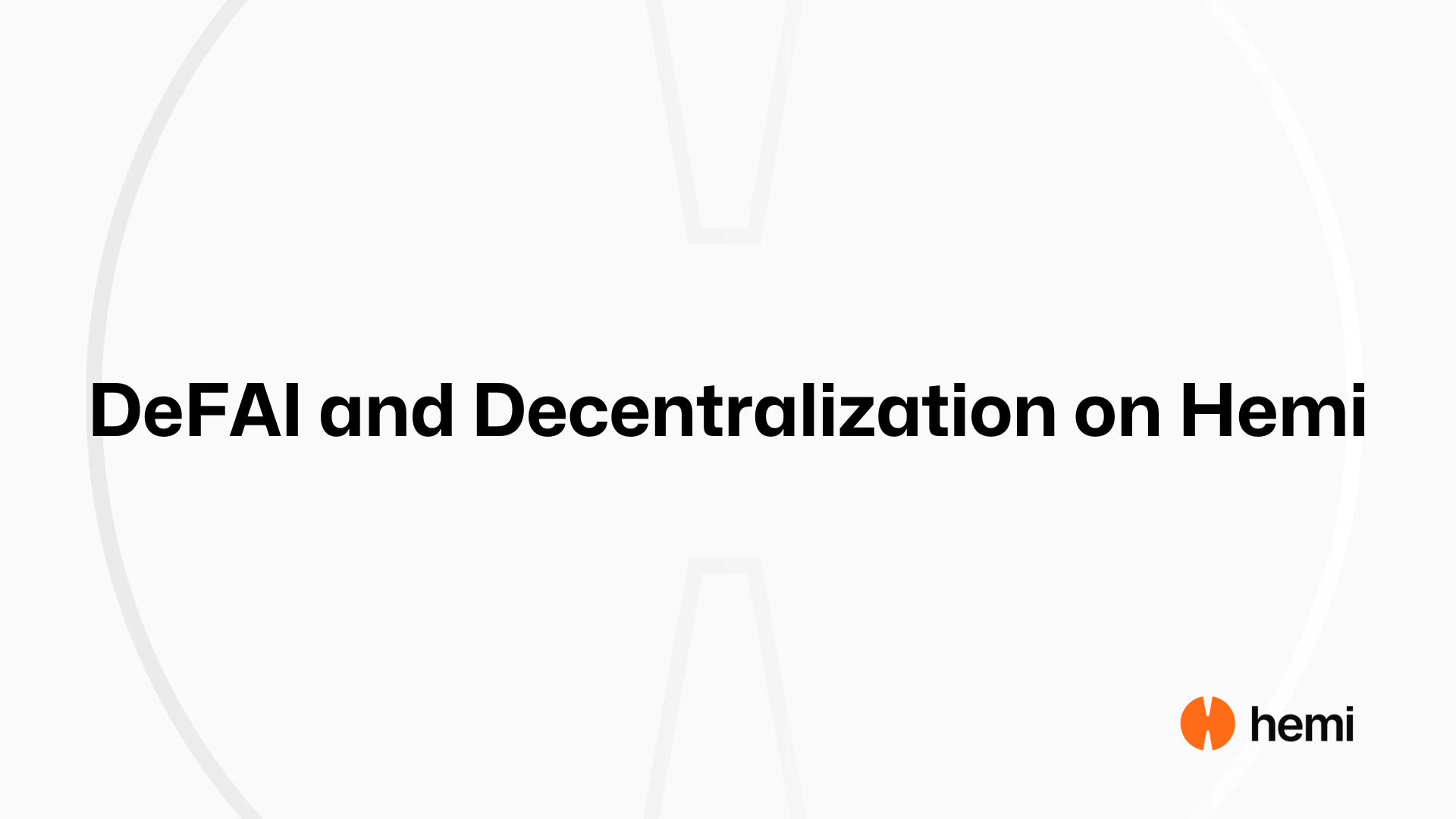DeFAI and Decentralization on Hemi
The rise of AI will reshape crypto. Here’s how Hemi helps.

The rapid evolution of AI is reshaping industries across the board, including blockchain and decentralized finance (DeFi). While concerns about misuse still exist, the current conversation is less about dystopian futures and more about how to build AI systems that are open, accountable, and decentralized.
Decentralized AI—sometimes referred to as DeFAI—is an emerging field focused on combining large language models (LLMs) and other AI tools with decentralized infrastructure. This approach aims to reduce dependence on a single provider, improve transparency, and enable new kinds of applications that align with the values of Web3.
One notable example is Truth Terminal, a chatbot developed by AI engineer Andey Ayrey. It gained attention for interacting with crypto traders on X and executing profitable DeFi trades on its own. Truth Terminal represents one of the first LLMs to function as an autonomous on-chain agent, showing how AI can operate in permissionless environments.
This is just the beginning. As developers continue experimenting with open models, autonomous agents, and on-chain coordination, decentralized AI is quickly becoming a meaningful part of the broader Web3 stack.
The Rise of the DeFAI Agent
It all began in July 2024, when a curious decision by venture capitalist Marc Andreeson to donate $50,000 in Bitcoin to Truth Terminal following an X exchange put AI agents on everyone’s radar. Fanning the fire with bizarre meme-driven outputs, Truth Terminal rose to the top of the crypto news cycle among DeFi traders, particularly with the promotion of the $GOAT cryptocurrency on the Solana network.
The bot proved to possess trading prowess, as its wallet accumulated tokens now valued in the hundreds of millions of dollars. As devs attempted to replicate Truth Terminal’s wild success it became a watershed moment for the convergence of AI and DeFi, the birth of a growing DeFAI movement, where sometimes sassy AI-driven agents vie for market share and mindshare alike.
Autonomous agents soon began executing investment strategies, analyzing market trends, and transacting across numerous chains. Simultaneously, tokens representing such agents emerged, representing these agents as financial instruments, further integrating them into the DeFi landscape.
Tokenized AI services have enormous potential, but their rise also raises critical concerns over how the growing influence of the harbingers of DeFAI wield their influence over markets and social behaviors.
Ethical DeFAI Deployment
While these advancements unlock potential, they also raise significant questions about governance, ethics, and transparency. Addressing these challenges is where the core principle of Web3, comes into play; decentralization. Sufficiently distributed blockchain networks provide governance mechanisms and transparent consensus mechanisms that address the systemic risk of AI implementations.
AI frameworks like Eliza Labs’ ElizaOS have taken steps toward the integration of Web3 and AI, demonstrating how such agents can operate effectively in decentralized environments by leveraging modular architectures. For AI agents, context-aware behavior is extremely important, and achieving it requires robust memory management, fine-tuned state tracking, and seamless multi-chain interaction.
ElizaOS succeeds with context-relevant decision-making so developers can use it as a framework to deploy agents ready to interact with smart contracts, manage tokenized assets, and potentially even generate NFTs while maintaining a baseline of decentralization.
By embedding AI within a trustless, immutable ledger, decisions can be verified, monitored, and audited. This preempts faulty decision points and reduces the vulnerability of tampering or unauthorized executions and ensures that AI applications operate securely, openly, and with responsibility, which can be difficult to achieve in centralized implementations.
Hemi’s Decentralized Approach to AI Integrity
Hemi integrates decentralization at every critical intersection of its architecture, ensuring a network primed to address the challenges of a rapidly evolving DeFAI arena. If an ideal DeFAI ecosystem champions accountability, Hemi provides an optimal foundation. Its architecture prioritizes transparency and decentralization, and the network achieves superfinality with its hybrid consensus mechanism.
By creating a trust-minimized environment fixated between Ethereum and Bitcoin, Hemi provides AI agents, such as those created via ElizaOS, with diverse datasets spanning multiple chains. Hemi supports both EVM-based and Bitcoin-based assets and dynamic multi-chain trading strategies. The network’s native support for Bitcoin and EVM-states eliminates the need for centralized oracles or price feeds that can be tampered with, ensuring that all onchain operations take place with a clear, auditable framework.
Proof-of-Proof, Hemi’s hybrid consensus model, further protects the network by anchoring validated transaction data to Bitcoin’s highly secure Proof-of-Work network. With a dual layer of validation, Hemi’s rigorous layers of decentralization deter rogue AI agents by establishing a clear, tamper-resistant chain of accountability for all AI-driven activities.
Hemi is ready to support the transformative use cases where AI and blockchain networks converge. Whether it’s decentralized identity systems, autonomous decision-making protocols, or secure data-sharing networks, Hemi lends its infrastructure to operational integrity. By prioritizing security, transparency, and distributed governance Hemi can support a more ethical and responsible DeFAI landscape.